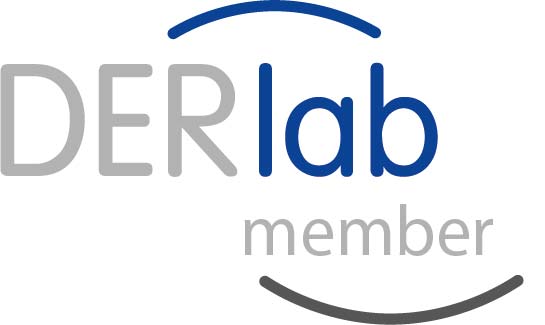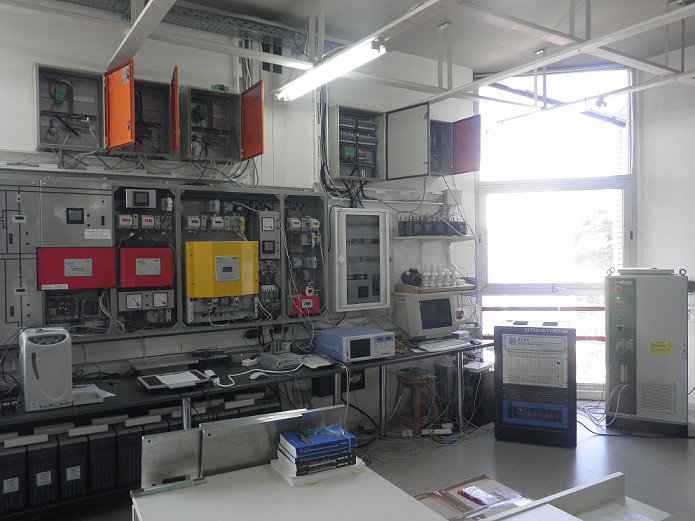 |
Country: Greece | 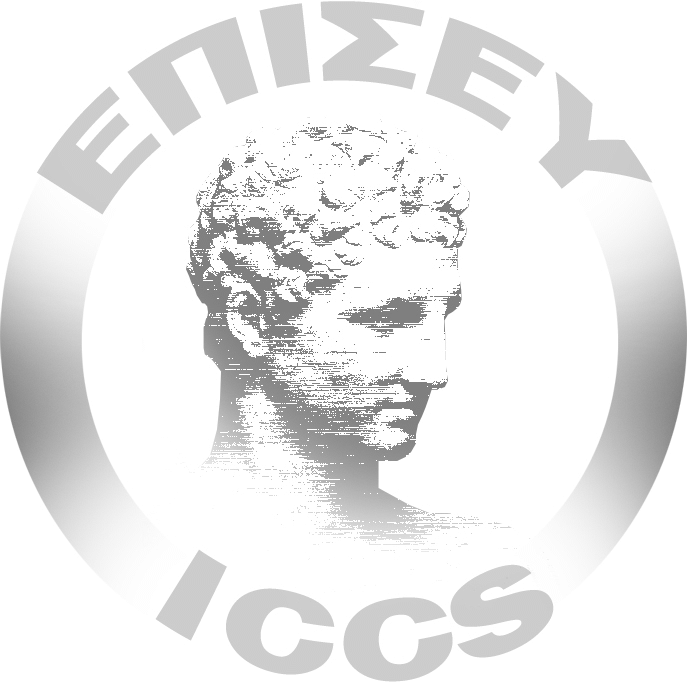 |
||
| Get free physical or remote access to this facility and its virtual services via the ERIGrid 2.0 Lab Access Programme. |
||||
| Submit Testing/Consulting Request | ||||
Description: The Institute of Communication and Computer Systems (ICCS) is a private law body associated with the Department of Electrical and Computer Engineering of the National Technical University of Athens (NTUA). ICCS has been established in 1989, in order to carry research and development activities in the fields of telecommunication systems and computer systems and their applications in a variety of applications, such as electric power systems, software and hardware engineering, control systems and biomedical engineering. The Electric Energy Systems Laboratory (EESL) is one of the Research Groups of ICCS and offers various degrees of experimental training for students, as part of relevant courses. NTUA has participated in more than 40 research projects, most of which are collaborative EU funded projects.
Smart RUE is one of the Research Groups of ICCS. It belongs to the Electric Energy Systems Laboratory (EESL) of the School of Electrical and Computer Engineering of the National Technical University of Athens. It was founded by Professor Nikos Hatziargyriou and operates under his supervision. It is composed of Professors, post-doctoral scientists, postgraduate students and highly specialized researchers and collaborators. It is technically and administratively supported by the personnel of EESL.
The main activities of Smart RUE focus in research and technology development in the area of Smart Grids. The main Smart RUE activities deal with planning and operation of modern power systems characterized by high penetration of renewable energy sources, distributed generation and flexible loads. For the efficient solution of related problems advanced control and ICT technologies are employed.
Dynamic Inductive EV Charging.
The dynamic inductive charging system, considers the wireless transfer of energy while an EV moves over the charging station. It comprises the magnetic coupler, compensation capacitors and the DC/AC converter that provides the required high frequency current to the charger. The implemented control scheme can significantly increase the efficiency of the system, while maximizing the energy transferred to the vehicle when it moves over the station. A relevant laboratory model has been set-up.
Anti-islanding testing
A laboratory setup for performing anti-islanding tests for both AC and DC systems has been developed based on the IEEE 1547.1 standard. PHIL tests are performed, that allow convenient and accurate detection in real-time simulation.
Simulation software of electric railway systems
The electric railway systems software tool simulates the operation of railway systems, aiming towards the optimization of their performance. The tool can model all kinds of railway electrical systems and main components such as rectifiers, storage devices and inverters in case of energy injection back to the distribution system.
Low Voltage Microgrid
| Description: Lead-Acid, vented type, 30 cells, 2 V, 250/370 AH. Inverter: SMA/Sunny Island/4.5 kVA, bi directional, suitable for grid-connected and islanded operation. |
| Description: Modules: 10 series connected – single crystal Si, 110W, 12 V per module. Inverter: SMA/Sunny Boy/1100W. |
| Description: PV inverter. |
| Description: Battery inverter. |
| Description: Wind turbine |
| Description: 3 phase axial flux PMSG, 850W. Inverter: SMA/Windy Boy/1700W. The wind turbine has been constructed at ICCS-NTUA lab. |
| Description: Wind turbine inverter. |
Multi-Agent System for Microgrid Operation
Laboratory SCADA
Power Hardware-in-the-Loop (PHIL) simulation environment
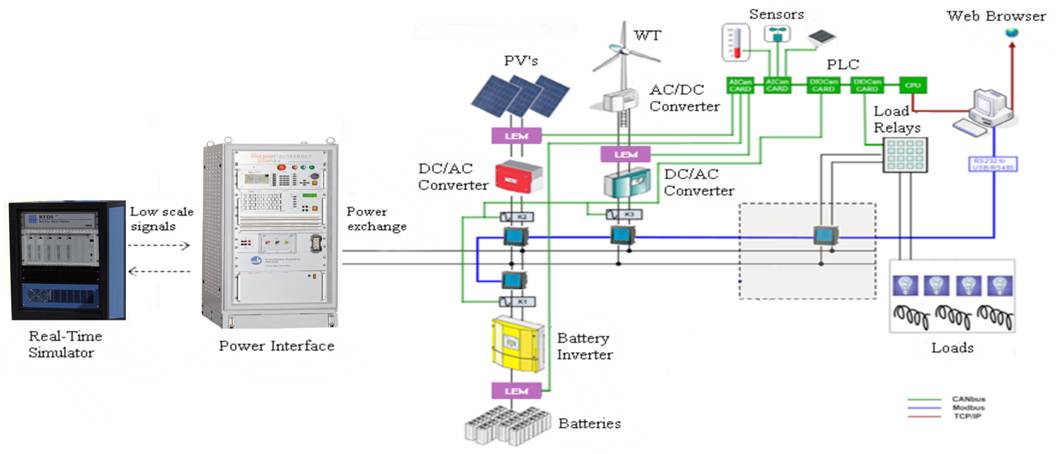
| Description: A Switched-Mode Amplifier provided by Triphase is used as a Power Interface between the RTDS and physical equipment to perform PHIL simulation. The power electronic converter platform allows the user to design a Matlab/Simulink control model, upload it to the Target PC (converter’s powerful control unit) and connect the user’s PC to the Target PC to allow real-time control of and interaction with the inverter cabinet. It also can operate as a 3ph AC/DC power converter rated at 15kVA, allowing for active and reactive power flows control and provision of ancillary services (e.g. frequency and voltage support, power quality improvement etc.). |
| Description: A linear amplifier with nominal power of 5kVA, capable of 4 quadrant operation and high bandwidth (DC – 5kHz). It can produce user-defined voltage and frequency profiles. It is used also as an interface between the RTDS and physical equipment to perform PHIL simulation. |
| Description: RTDS Simulator is used for performing real time power system simulation. A Power Hardware in the loop (PHIL) simulation environment for DER power devices (e.g. PV inverters) has been developed. An environment for real-time simulation, analysis and validation of digital relay models has been developed for Control Hardware in Loop (CHIL) applications. |
Controller Hardware in the Loop (CHIL) simulation environment
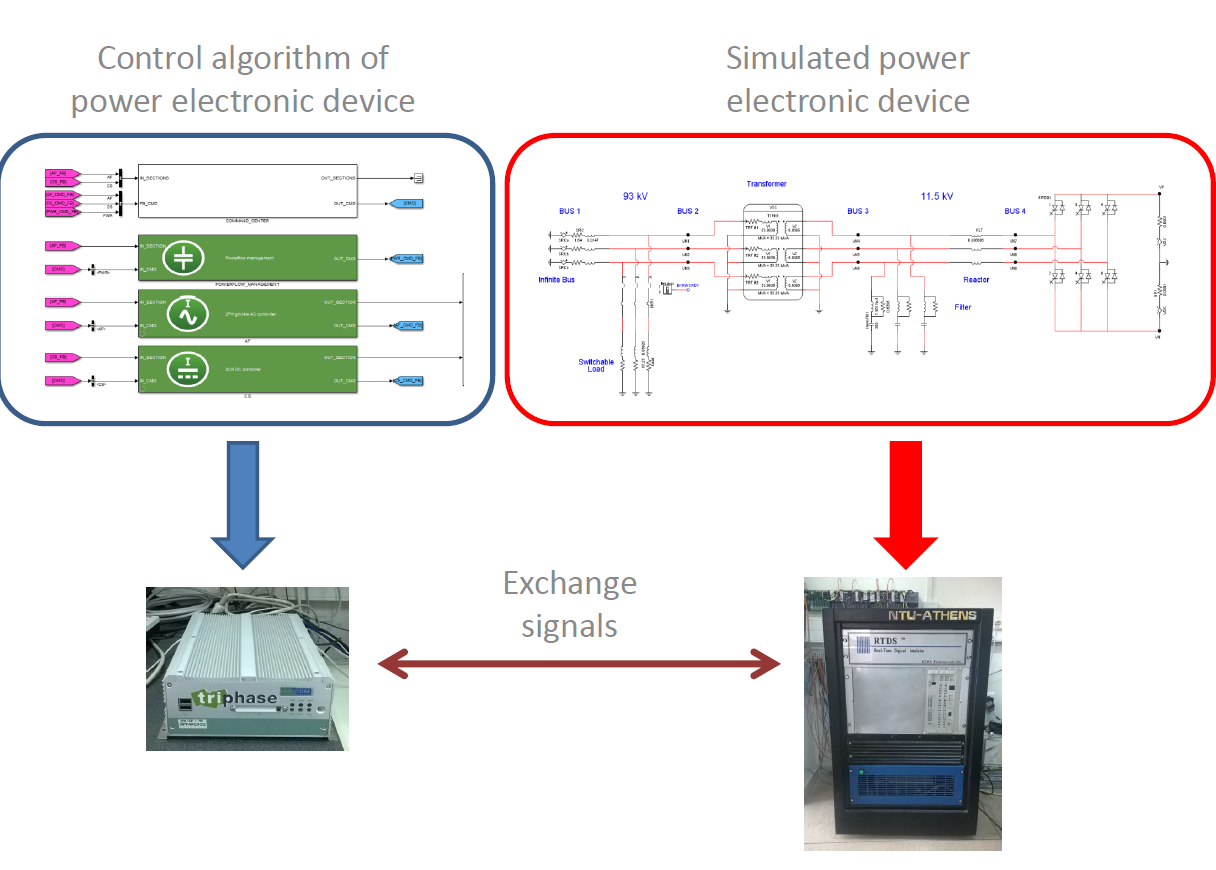
Adaptive Protection System in Distribution Grids with DER Penetration in a HIL environment
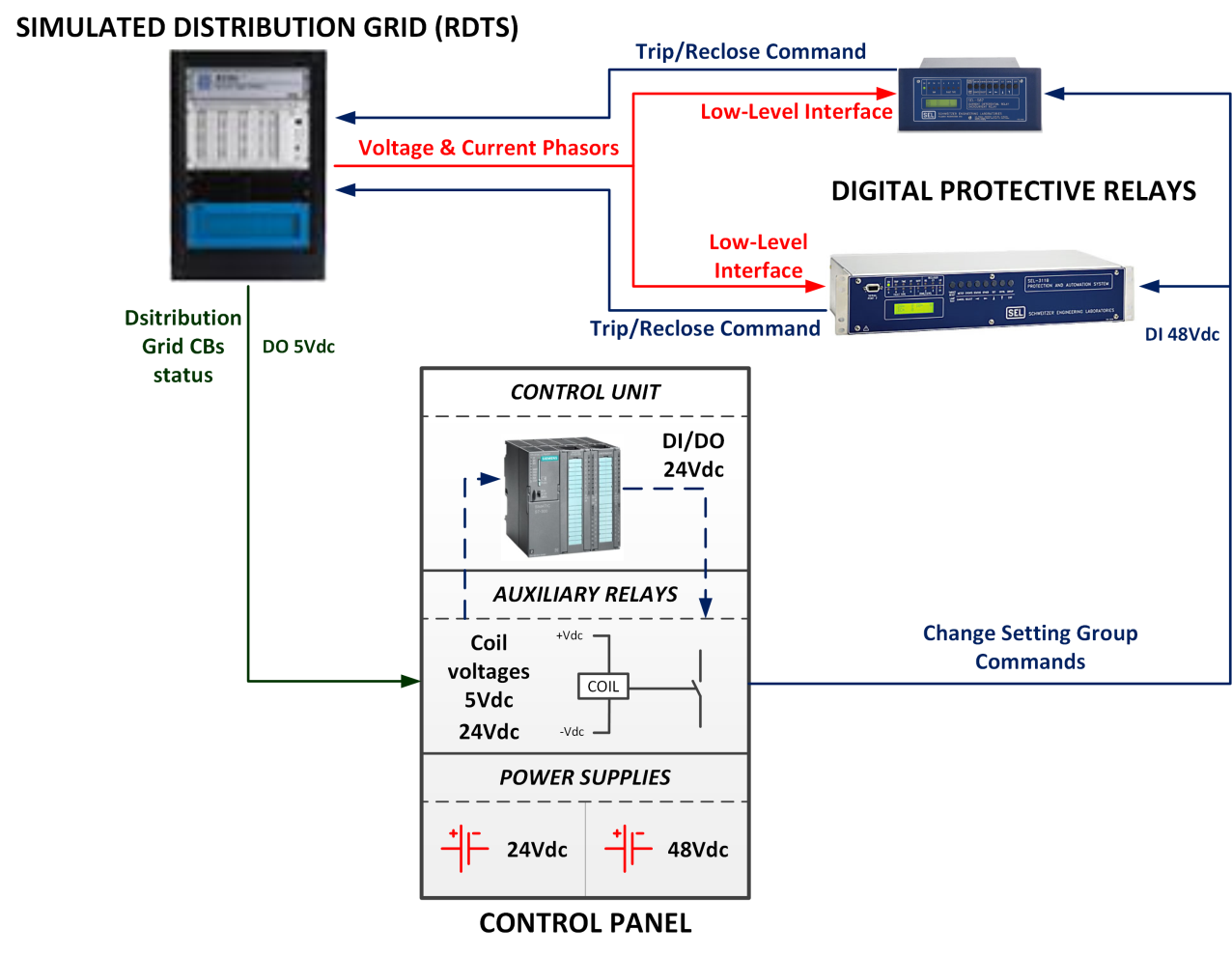
PV inverter testing according to standards
| Description: A three channel DC source with 3x10kW nominal power, used as a PV simulator which can simulate a PV string (characteristic V-I curve) and control environmental conditions (solar radiation, temperature). |
| Description: A linear amplifier which an produce user-defined voltage and frequency profiles. It is used also as an interface between the RTDS and physical equpment to perform PHIL simulation. |
Flexible Power Electronics Configuration for Coupling RES & Storage
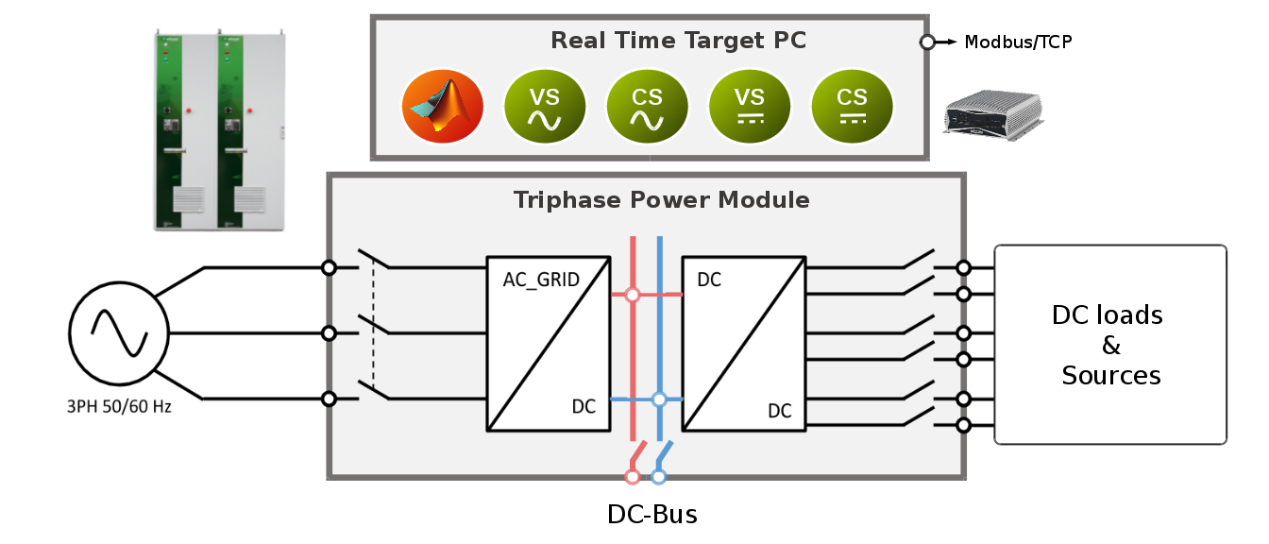
| Description: Three channel DC/DC converter able to interface and fully control voltages and currents up to 3 different distributed generators and storage (e.g. Photovoltaics, Batteries, Super Capacitors). The power electronic converter platform allows the user to design a Matlab/Simulink control model, upload it to the Target PC (converter’s powerful control unit) and connect the user’s PC to the Target PC to allow real-time control of and interaction with the control cabinet. |
Axial flux generator bench testing facilities
Residential Wind and Hydro Turbines construction
E-Mobility
- An EV (Electric Vehicle) emulator supporting the interoperability testing of the EV related protocols (IEC61851) is developed. It can be connected to an EVSE (Electric Vehicle Supply Equipment), as the device under testing, in order to validate its compliance with the standards.
- An EVSE emulator allowing the charging of a real or emulated EV in respect to IEC61851. The EVSE can also communicate with external stakeholders, i.e. the EVSEO, implementing the OCPP 1.5 protocol. Apart from the EVSE emulator, a commercial EV charging station (ETREL wallbox- 32A) is also available with smart charging capabilities.
- An EVSEO (Electric Vehicle Supply Equipment Operator) adopting the OCPP 1.5 protocol for the communication with custom-made or commercial EVSE.
- A custom-made energy management system with user interface offering several services to e-mobility stakeholders such as searching for EVSE location, electricity price information, EVSE availability, booking capabilities. The interaction between the EV user interface and the EVSEO is realized via Rest-Based Web Service technology.
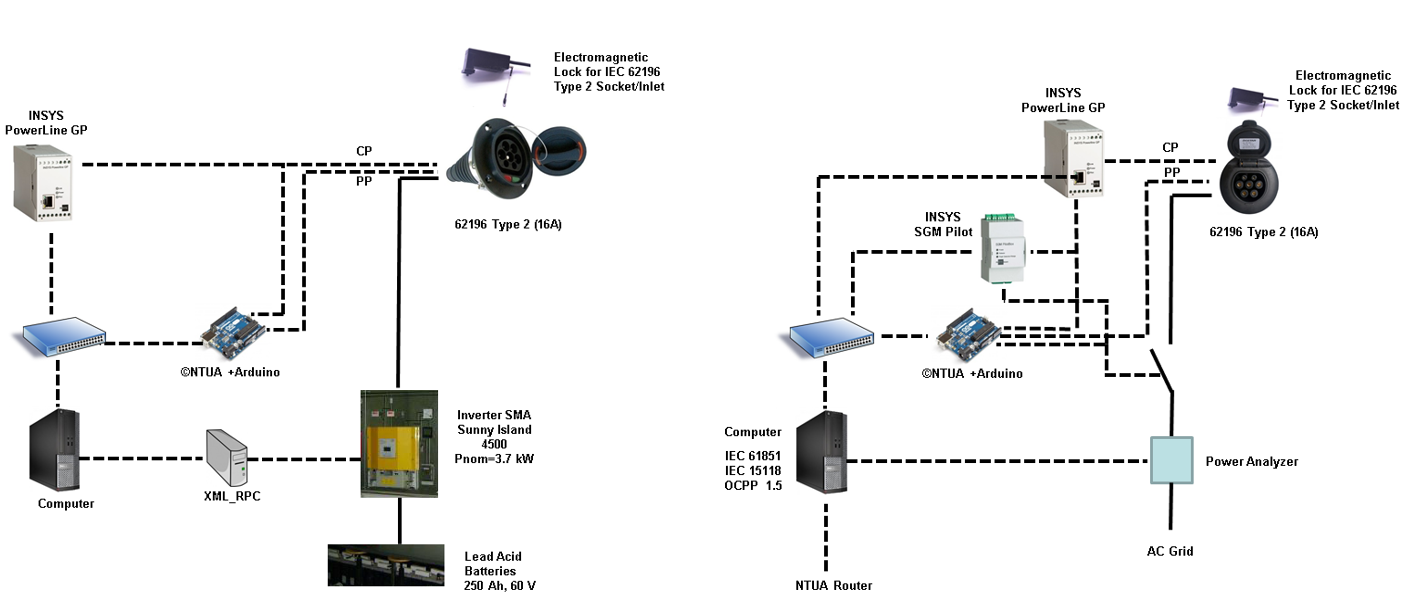
Additional eqipment
| Description: Three Phase Variable Resistance |
| Description: Three Phase Variable Inductance |
| Description: Three Phase Transmission line |
| Description: Three Phase Variable Capacitance |
| Description: Three Phase Transformer |
| Description: Three Phase Regulating Autotransformer |
| Description: Three Phase Controlable Feeder |
| Description: Three Phase Controlable Feeder |
| Description: Three Phase Transmission line |
| Description: Graphical Multimeter |
| Description: Power Harmonics Analyzer |
| Description: Power Quality Analyzer |
| Description: Digital Storage Oscilloscope |
| Description: Megger Tester |
| Description: Digital Oscilloscope |
| Description: Precision Power Analyzer |
OpenAFPM
The OpenAFPM (Online Design Tools for Locally Manufactured Small Wind Turbines) modelling tools can be used for designing Axial Flux Permanent Magnet (AFPM) generators for wind electric systems with the use of the open source finite element analysis software “Finite Element Method Magnetics” (FEMM). This series of design tools have been developed by ICCS, in order to assist designers and practitioners involved with small scale wind electric systems. The tool is also used for educational purposes.
Virtual Lab
The Virtual Lab is an online educational simulation tool that mimics the operation of the actual laboratory microgrid of EES lab of ICCS. A mathematical model of the laboratory microgrid has been developed along with a friendly GUI. The user can observe several variables (e.g., voltage, active power, reactive power etc.) and perform several actions (e.g. change the power factor of the inverter). The simulation tool includes two different laboratory setups and corresponding experiments: voltage control, and microgrid operation.
OMNeT++
JADE (Java Agent DEvelopment Framework)
RSCAD
GAMS (General Algebraic Modeling System)
Eurostag
The main services offered by the above facilities are:
- Performance of Power Hardware-in-Loop testing of DER devices integrated with the RTDS simulator. MIMO PHIL tests can also be performed using the two power amplifiers of the lab.
- CHIL applications with the RTDS simulator and an external Triphase Target PC which allows the design of the control algorithm in Matlab/Simulink and it’s testing in real time.
- Testing both local and remote by Multi Agent System (MAS) technology and performance of optimizations.
- Fast testing of developed control algorithms (Matlab/Simulink) in flexible hardware power electronic converters (DC/DC, DC/AC, AC/DC/AC) provided by Triphase.
- Power curve measurement of Small Wind Turbines.
- Small wind turbine generator testing.
- Testing and validation of DG components within the Microgrids operation.
- Testing commercial or custom made e-mobility products for their compliance with EV standards/protocols (IEC61581, OCPP).
- Developing and testing EV smart management algorithms in lab environment (microgrids).
- Testing and validating EV integration within simulated distribution network in the RTDS.
- PV inverter testing according to standards.
- Testing of protection schemes with the RTDS.
- Steady state and dynamic simulations of power systems with high RES penetration: using various in-house and commercial packages.
- Static and Dynamic Maximum Power Point Tracking (MPPT) (EN 50530)
- EMC tests (IEC 61000-3-2, Harmonic measurements 0-100KHz, etc.)
- Connection requirements (VDE-AR-N 4105)
- Fault ride through (VDE 0126-1-1)
- Anti-islanding Requirements (In progress)
- IEC61851
- OCPP 1.5
Metering data security and personal data protection: According to Article 10 of Directive 2012/27/EE by 25.10.2012, HEDNO (Hellenic Electricity Distribution Network Operator) has taken care of the distribution and statistical analysis of metering data in accordance with the principle of transparency and the protection of consumer’s personal data. In addition to the above, HEDNO has also taken care to the complete implementation by 09.03.2012 Commission Recommendation (2012/148EE) in accordance with the existing Union and national origin regulatory framework for the protection of personal data (see Article 8 of the Chart of Fundamental Rights of the European Union, Directive 2006/24/EC, Directive 2002/58 and Law 2472/1997). The security of the metering data is achieved with its transfer through private channels of communication (VPN) and leased lines of Communication Providers, while passwords encrypted with SSL certificate are used in the Web application.
HEDNO
- Smart Meter standard in Greece: IEC 62056
- Important equipment vendors for SCADA components in Greece: SIEMENS and EFACEC
- Most used broadband technologies to control SCADA systems in Greece: GSM, radio communication, ISDN
- Most important Greek standardisation organisation: ELOT
- Communication protocol, considered as most important in the future: IEC 61850
- P. Kotsampopoulos, A. Rigas, J. Kirchhof, G. Messinis, A. Dimeas, N. Hatziargyriou, V. Rogakos, K. Andreadis:
EMC issues in the interaction between smart meters and power electronic interfaces
IEEE Transactions on Power Delivery, Volume: PP, Issue: 99, May 2016. - N. Hatziargyriou, M. Maniatopoulos, D. Lagos, V. Kleftakis, V. Papaspiliotopoulos, P. Kotsampopoulos, G. Korres:
CHIL and PHIL simulation for testing modern distribution network control and DER
Presentation in Panel at the IEEE Power & Energy Society General Meeting 2016, Boston, July 2016. - M. Panteli, D. N. Trakas, P. Mancarella and N. D. Hatziargyriou:
Boosting the Power Grid Resilience to Extreme Weather Events Using Defensive Islanding
IEEE Transactions on Smart Grid, vol. 7, no. 6, pp. 2913-2922, Nov. 2016. - N. Hatziargyriou, D. N. Trakas, M. Panteli, P. Mancarella:
Assessing and Boosting Power System Resiliency to Extreme Weather Events
Presentation in Panel at the IEEE Power & Energy Society General Meeting 2016, Boston, July 2016. - D. N. Trakas, M. Panteli, P. Mancarella, and N. D. Hatziargyriou:
A Severity Risk Index for High Impact Low Probability Events in Transmission Systems due to Extreme Weather
ISGT 2016, Ljubljana, 2016. - Karagiannopoulos, S., Rigas, A., Hatziargyriou, N., Hug, G., & Oudalov, A.:
Battery energy storage capacity fading and control strategies for deterministic and stochastic power profiles
In Power Systems Computation Conference (PSCC), 2016 (pp. 1-7). Power Systems Computation Conference, June 2016. - G. Messinis, A. Dimeas, V. Rogkakos, K. Andreadis, I. Menegatos and N. Hatziargyriou:
Utilizing smart meter data for electricity fraud detection
SEERC Power Conference, Portoroz, Slovenia, 7th—8th June 2016. - G. Messinis, I. Kokos, I. Lamprinos, A. Dimeas and N. Hatziargyriou:
ICT tools for enabling smart grid players’ flexibility through VPP and DR services
13th International Conference on the European Energy Market (EEM), Porto, 2016. - T. Sarris, G. Messinis and N. Hatziargyriou:
Residential demand response with low cost smart load controllers
10th Mediterranean Conference on Power Generation, Transmission Distribution and Energy Conversion (MedPower), Belgrade, 2016. - Hatziargyriou, N. D., Kleftakis, V. A., Papadimitriou, C. N. and Messinis, G. M.:
Microgrids in Distribution
Smart Grid Handbook. 1–24. - I. Karakitsios, E. Karfopoulos, N. Hatziargyriou:
Impact of dynamic and static fast inductive charging of electric vehicles on the distribution network
Electric Power Systems Research, Volume 140, Pp. 107–115, November 2016.
Journals
- Salcedo, E. Corbett, C. Smith, E. Limpaecher, R. Reekha, J. Nowocin, G. Lauss, E. Fonkwe, M. Almeida, P. Gardner, S. Manson, B. Nayak, I. Celanovic, C. Dufour, M.O. Faruque, K. Schoder, R. Brandl, P. Kotsampopoulos, T. N. Ha, A. Davoudi, A. Dehkordi, K. Strunz:
Banshee Distribution Network Benchmark and Prototyping Platform for Hardware-in-the-Loop Integration of Microgrid and Device Controllers
The Journal of Engineering, ΙΕΤ, March 2019 - I. Strasser, F. Pröstl Andrén, E. Widl , G. Lauss, E.C.W. De Jong, M. Calin, M. Sosnina, A. Khavari, J. E. Rodriguez, P. Kotsampopoulos, M. Blank, C. Steinbrink, K. Mäki, A. Kulmala, A. van der Meer , R. Bhandia, R. Brandl, G. Arnold, C. Sandroni, D. Pala, D. E. Morales Bondy , K. Heussen , O. Gehrke , F. Coffele, Q.T. Tran, E. Rikos, V. H. Nguyen , I. Orue, M. Z. Degefa, S. Manikas:
An integrated pan-European research infrastructure for validating smart grid systems
e & i Elektrotechnik und Informationstechnik, Volume 135, Issue 8, December 2018 - Kotsampopoulos, D. Lagos, N. Hatziargyriou, M.O. Faruque, G. Lauss, O. Nzimako, P. Forsyth, M. Steurer, F. Ponci, A. Monti, V. Dinavahi, K. Strunz:
A Benchmark System for Hardware-in-the-Loop Testing of Distributed Energy Resources
IEEE Power and Energy Technology Systems Journal, vol. 5, no. 3, Sept. 2018
Conferences
- Brandl, P. Kotsampopoulos, G. Lauss, M. Maniatopoulos, M. Nuschke, J. Montoya, T.I. Strasser, D. Strauss-Mincu:
Advanced Testing Chain Supporting the Validation of Smart Grid Systems and Technologies
IEEE Workshop on Complexity in Engineering (COMPENG), Florence, October 2018 - C. Seitl, M. Maniatopoulos, T. Strasser, P. Kotsampopoulos:
Time Synchronous Control of Grid- and PV- Emulators for Laboratory Testing within a Co-Simulation Environment
CIRED Workshop, Ljubljana, June 2018 - T.I. Strasser, M. Sosnina, E. de Jong, E. Rodriguez, P. Kotsampopoulos, C. Steinbrink, A. Kulmala, R. Bhandia, R. Brandl, C. Sandroni, E. Bondy, F. Coffele:
European research infrastructure supporting smart grid systems technology development validation and roll out
8th International Conference on Integration of Renewable and Distributed Energy Resources, IRED 2018, Vienna, October 2018 - J. Montoya, R. Brandl, M. Vogt, F. Marten, A. Fabian, M. Maniatopoulos:
Asynchronous Integration of a Real-Time Simulator to a Geographically Distributed Controller through a Co-Simulation Environment
44th Annual Conference of the IEEE Industrial Electronics Society, IECON 2018, Washington, October 2018
last updated: 24.10.2019

